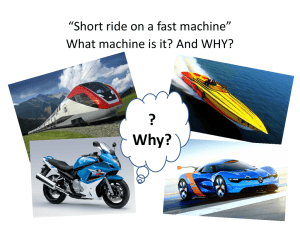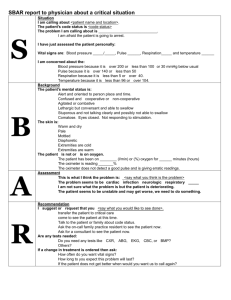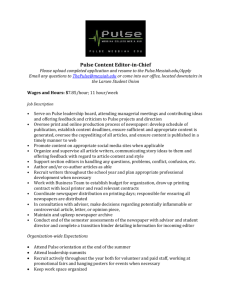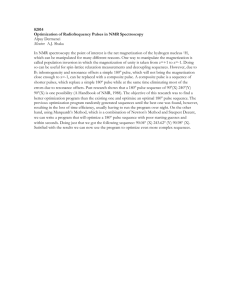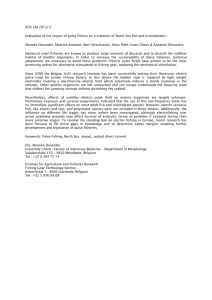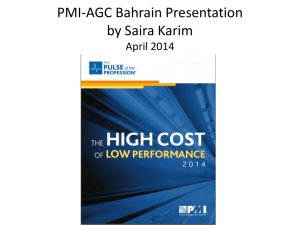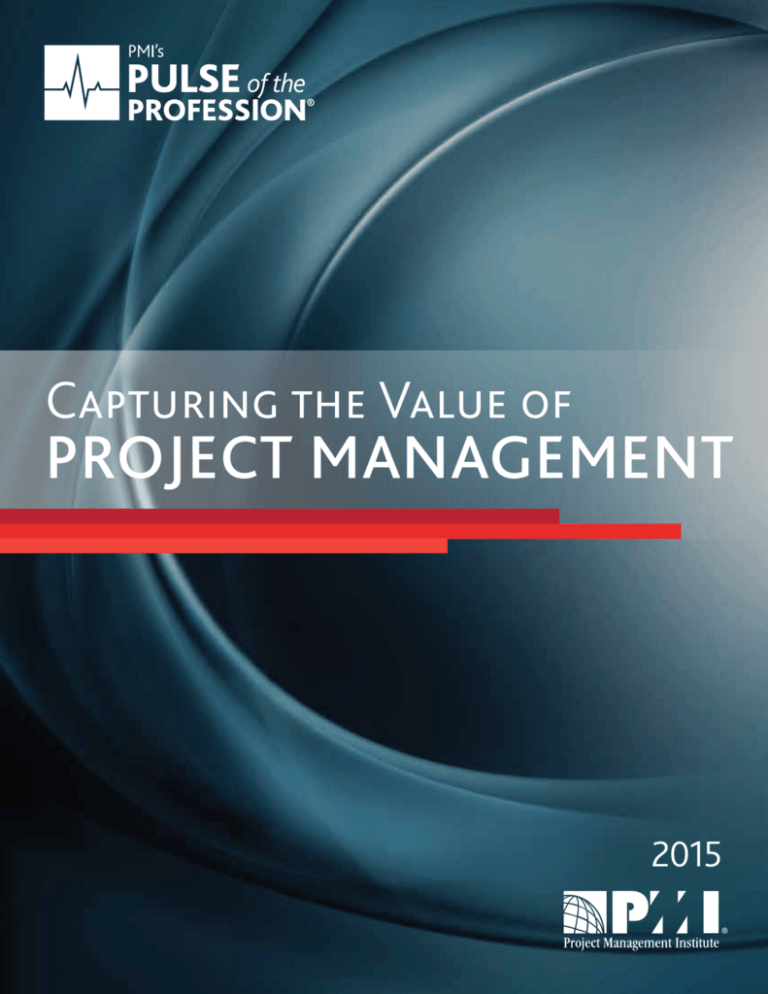
Capturing the Value of
PROJECT MANAGEMENT
2015
Pulse of the Profession®: Capturing the Value of Project Management
February 2015
VALUING PROJECT, PROGRAM, AND
PORTFOLIO MANAGEMENT
All change in an organization happens through projects and programs—by
many different names. When a project and program management mindset
is embedded into an organization’s DNA, performance improves and
competitive advantage accelerates. In fact, according to our 2015 Pulse of the
Profession® study, the projects of high-performing organizations successfully
meet goals two–and–a–half times more often, and these organizations waste
13 times less money than their low-performing counterparts.
This reality, reported annually by our Pulse study, demonstrates the value
project management delivers—and is fully understood by more than half of all
organizations (55 percent) in this year’s findings. While that would seem to be
good news, the number of organizations recognizing and capturing this value
remains unchanged since 2012, so there is more work to be done.
As the global advocate for the project, program, and portfolio management
profession, we have conducted our Pulse study since 2006 to provide
evidence that implementing strategy successfully is inextricably linked to an
organization’s capability to deliver successful projects and programs.
Throughout this report, you will discover what high-performing organizations
do differently—and how they are creating competitive advantage by
embedding a project management mindset in their organization’s culture.
These organizations have adopted global standards. They understand
the importance of a highly trained, professionally certified workforce.
And, they are reaping the rewards of this disciplined approach to strategy
implementation.
2
©2015 Project Management Institute, Inc. PMI.org/Pulse
Pulse of the Profession®: Capturing the Value of Project Management
February 2015
In this report, we will explore the Pulse findings in greater detail and demonstrate a clear path forward
through a focus on the following fundamentals, which essentially take us back to the basics.
• Culture: High-performing organizations fully understand the value of project management and are creating a project management mindset.
• Talent: High-performing organizations are significantly more likely to focus on talent management, establishing ongoing training, and formal, effective knowledge transfer. This is especially important in project management, where technical skills are enhanced by the leadership and strategic and business management capabilities that are nurtured through experience.
• Process: High-performing organizations support project, program, and portfolio management though standardized practices and by aligning projects and programs to the organization’s strategy.
The 2015 Pulse finds that organizations continue wasting US$109 million for every US$1 billion invested in
projects and programs. But organizations that embrace, value, and utilize project management—and both
recognize and attribute their success to it—report more success, less waste and achieve greater competitive
advantage.
Spread the word—and let’s do great things together.
Mark A. Langley
President and CEO
Project Management Institute
©2015 Project Management Institute, Inc. PMI.org/Pulse
3
Pulse of the Profession®: Capturing the Value of Project Management
February 2015
EXECUTIVE SUMMARY: 2015 TRENDS
As we look at the state of project, program, and portfolio management in 2015, we see that a number
of global dynamics are forcing organizations to take a more critical look at how they operate. Sluggish
economic growth continues, putting additional emphasis on how well organizations execute their strategic
initiatives. This, in turn, requires more rigorous project, program, and portfolio management. Yet over the
past few years, many of our Pulse findings about how well organizations are delivering on their strategic
initiatives have remained largely unchanged. That leads us to ask “why,” but also suggests it’s time for
organizations to revisit the fundamentals of project management and, essentially, go back to the basics.
Those basics include:
• Fully understanding the value of project management
• Having actively engaged executive sponsors
• Aligning projects to strategy
• Developing and maintaining project management talent
• Establishing a well-aligned and effective PMO (project management office)
• Using standardized project management practices throughout the organization
We also see opportunity for greater attention to a number of foundational practices, which our research
shows high performers1 are more likely to focus on compared to their lower-performing2 counterparts,
including:
• Greater knowledge transfer effectiveness: The number of organizations that have high effectiveness has increased by 20 percent since last year.
• More rigorous risk management: This year, 83 percent of high performers report frequent use of risk management practices, compared to only 49 percent of low performers.
• More frequent use of agile/incremental/iterative practices in project management: The use of these practices continues to rise, with 38 percent of organizations reporting frequent use, up 8 percentage points since 2013.
• Higher benefits realization maturity: Though only one in five organizations reports having a high level of benefits realization maturity, we’ve seen an increase of 63 percent compared to the level
in 2013.
As the world’s largest project management association, we know that even the best organizations—maybe
especially the best—are always looking to improve. The following pages explore the 2015 Pulse findings in
greater detail, with an additional focus on how organizations can build and sustain their capabilities and
create greater competitive advantage.
4
©2015 Project Management Institute, Inc. PMI.org/Pulse
Pulse of the Profession®: Capturing the Value of Project Management
February 2015
DELIVERING VALUE IN A DEMANDING ENVIRONMENT
The economic and business environments continue to be challenging. Global
GDP growth did not improve to the levels economists had hoped to see at
the start of 2014: In January, The Economist Intelligence Unit (EIU) projected
the global economy would grow by 3.6 percent; however, in December, they
revised the 2014 projected growth rate down to 3.1 percent. For 2015, the EIU
projects a 3.8 percent global growth rate (Figure 1).3
Figure
Figure1:1:Global
GlobalGDP
GDPGrowth
Growth
5.2%
—Philippe Guitton, Michelin
5%
3.8% 3.8% 3.8% 3.9%
3.8%
3.6%
3.1%
2.9% 2.9%
2.5%
2007
“To me [change] will come
from management and
influencing behavior.”
2009
2011
2013
2015
2017
2019
-0.8%
Year
1. Source: EIU Global Forecasting Service
2. 2015 – 2019 are forecasts
Similarly, many of our Pulse findings have remained stable for the past four
years, not showing significant decreases—or increases. Why aren’t these
numbers moving? What will cause noticeable change?
“To me it will come from management and influencing behavior,” said Philippe
Guitton, IT Quality and P. Office Director, Michelin. “It’s imperative to hire the
right project managers who have sufficient skill and education to convince
their teams about the methods: what is not negotiable, what is optional. They
need to make a strong case because it’s never possible to impose methods and
expect people to comply.”
©2015 Project Management Institute, Inc. PMI.org/Pulse
5
Pulse of the Profession®: Capturing the Value of Project Management
“I believe more focus on
selling the concept of OPM
and its value to the C-suite
is essential to cause a
noticeable change.”
—Laila MT Faridoon, Roads and Transport Authority
February 2015
Progress will also come as perception changes. “... no matter how far we
progress, maturity or OPM type assessments will always show us as midlevel, not because we’re not improving, but because I think our understanding
and expectations are also increasing, so we keep seeing our flaws,” said
Chris Lawler, PfMP, Manager, Project Portfolio Office, Mater Health Services.
“It may be that our inner gauge is faulty. We kind of keep shifting our own
benchmark.”
“The main reason is the perception of project management concept by
the C-suite, it is very much limited to the execution phase of project
management, they lack awareness of the concept of organizational project
management [OPM] and its role and contribution to strategy execution and
value added to driving business success,” said Laila MT Faridoon, Director of
the Chairman’s Office, Head of the Enterprise Programme Management Office
(EPMO), Roads and Transport Authority (RTA). “I believe a more focus on
selling the concept of OPM and its value to the C-suite is essential to cause a
noticeable change.”
BACK TO BASICS: IMPROVING PROJECT
MANAGEMENT
High-performing organizations are demonstrating that adhering to proven
project, program, and portfolio management practices reduces risks, cuts
costs, and improves success rates of projects and programs. This focus
emphasizes the need for all organizations to get back to basics: By embedding
a project management mindset in their culture, they will be better able to
create a sustainable competitive advantage.
High-performing organizations drive project management and deploy related
competencies with a goal of maximizing organizational value. Our Pulse
study shows that projects within these organizations meet original goals
and business intent two-and-a-half times more often than those in lowperforming organizations (90 percent vs. 36 percent).
High-performing organizations also waste about 13 times less money than
low performers. But we have not seen an increase in the number of highperforming organizations since 2012. This number remains steady at 12
percent.
What helps an organization build and sustain its growth capacity and become
a high performer?
6
©2015 Project Management Institute, Inc. PMI.org/Pulse
Pulse of the Profession®: Capturing the Value of Project Management
Our Pulse research shows a number of factors contribute to this success,
including a focus on what we consider the basics:
• Fully understanding the value of project management
• Having actively engaged executive sponsors
• Aligning projects to strategy
• Developing and maintaining project management talent
• Establishing a well-aligned and effective PMO
• Using standardized project management practices throughout the organization
“Many people talk about the value of project management without knowing
what it really means,” said Mr. Guitton. “Everyone agrees about the value for
doing the projects, but interest is different from opportunity—and we need to
collect the benefits. The devil is in the details and organizations should focus
there.”
February 2015
“Many people talk about
the value of project management without knowing
what it really means ...
interest is different from
opportunity–and we need
to collect the benefits.”
—Philippe Guitton, Michelin
BUSINESS IMPERATIVES: GETTING THE
FUNDAMENTALS RIGHT
Organizations are more likely to nurture a culture of project management
when they fully understand the value it brings and how projects and programs
drive change. They also understand that when projects fail, so do profits,
because organizations are less likely to achieve strategic goals.
Our Pulse study shows that these organizations are focusing on the
fundamental aspects of culture, talent, and process that support excellence
in project, program, and portfolio management. As a result, significantly more
of these organizations’ projects, including those focused on their highest
priorities—strategic initiatives—are meeting their goals.
©2015 Project Management Institute, Inc. PMI.org/Pulse
7
Pulse of the Profession®: Capturing the Value of Project Management
February 2015
But the percentage of projects meeting their goals—our measure of success—has remained flat over the
past four years, as outlined in the chart below (Figure 2). We suspect that until more organizations address
these fundamentals—and get better at managing them—overall project success rates will not improve.
Keep in mind that high performers have these basic principles in place and are experiencing two-and-a-half
times more successful projects.
Figure 2: Percentage of Projects Meeting Goals
Figure 2: Percentage of Projects Meeting Goals
64%
62%
2012
2013
64%
64%
2014
2015
Year
Culture
The most effective organizations recognize the need for formal project and program management in their
“change the business” initiatives. Creating a culture that embraces project management and increases the
business value it delivers involves:
• Fully understanding the value of project management
• Requiring actively engaged executive sponsors on projects and programs
• Aligning projects and programs to the organization’s strategy
• Having highly mature project, program, and portfolio management
Our 2015 Pulse study indicates high performers are significantly more likely to reflect the characteristics
listed in the chart below (Figures 3, 4 & 5). In fact, organizations that share these qualities have, on average,
more successful projects.
8
©2015 Project Management Institute, Inc. PMI.org/Pulse
Pulse of the Profession®: Capturing the Value of Project Management
February 2015
Figure 3: High-Performing Organizations Create
a Culture of Project Management
Figure 3: High-Performing Organizations
Create a Culture of Project Management
81%
80%
57%
45%
36%
29%
40%
36%
9%
Organizations fully
understand value of
project management
High performers
Actively engaged
sponsors
High alignment
of projects to
strategy
High project
management
maturity
35%
8%
High program
management
maturity
8%
High portfolio
management
maturity
Low performers
Figure 4
TheFigure
2015 Pulse
that,
on average,
4: Thestudy
2015finds
Pulse
study
finds that, on average
64%
of projects
are successful
64%
of projects
are successful.
64%
Figure 5: Components of Successful Projects
Figure 5: Components of Successful Projects
77%
70%
56%
Organizations fully
understand value of
project management
46%
46%
Actively engaged
sponsors
% successful projects
with item in place
74%
71%
High alignment
of projects to
strategy
54%
High project
management
maturity
76%
54%
High program
management
maturity
76%
56%
High portfolio
management
maturity
% successful projects
without item in place
©2015 Project Management Institute, Inc. PMI.org/Pulse
9
Pulse of the Profession®: Capturing the Value of Project Management
“Culture starts with how
employees see themselves
in the company, how they
see themselves in the
projects they work on…”
—Bob Bulger, WH Pacific
February 2015
Organizational culture sets the tone, that ultimately shapes the common
experiences of employees. Most organizations have developed unique cultures
over time by practice and common usage. Common experiences identified
in A Guide to the Project Management Body of Knowledge (PMBOK® Guide)
include, but are not limited to:
• Shared visions, mission values, beliefs, and expectations
• Regulations, policies, methods, and procedures
• Motivation and reward systems
• Risk tolerance
• Views on leadership, hierarchy, and authority relationships
• Code of conduct, work ethic, and work hours
• Operating environments
These characteristics indicate that culture and style are learned and can be
shared—and have a strong influence on a project’s ability to meet objectives.4
“Culture starts with how employees see themselves in the company, how
they see themselves in the projects they work on—the programs. And then
ultimately how they align into the company,” said Bob Bulger, PMP, PgMP,
PfMP, Chief Project Officer and Vice President of Operations of WH Pacific,
part of Nana Development Corporation.
Talent
A key factor in fostering a culture that values project management is
understanding the importance of skilled talent. According to the 2014 PMI and
EIU global survey, Rally the Talent to Win: Transforming Strategy into Reality,
only 17 percent of respondents say their talent management strategies are
quick to react to changing business conditions, whereas for one-third, effective
response takes several years or longer. Such widespread weakness takes its
toll: On average, for all companies surveyed, talent deficiencies significantly
hamper 40 percent of strategy implementation efforts.5
“Talent management to me is very important because without it the right
people in project and program and portfolio management, we won’t succeed,”
said Wanda Curlee, PMI-RMP, PMP, PgMP, PfMP, Director, Project, Program,
Portfolios at Hewlett-Packard.
10
©2015 Project Management Institute, Inc. PMI.org/Pulse
Pulse of the Profession®: Capturing the Value of Project Management
February 2015
Our research continues to show that when organizations invest in development and training for professional
project managers, they achieve superior project performance, execute strategic initiatives more successfully
and become high performers. High-performing organizations are significantly more likely to focus on talent
management,
establishing ongoing Organizations
training, and formalFocus
and effective knowledge transfer, as outlined in the
Figure
6: High-Performing
charts
below
(Figures
4,
6
&
7).
on Talent Management
Figure 6: High-Performing Organizations
Focus on Talent Management
80%
75%
65%
62%
51%
36%
35%
33%
32%
6%
Ongoing training
for project managers
High performers
Formal process
to develop project
manager competency
Formal knowledge
transfer process
Defined career
path for project
managers
Highly effective
knowledge transfer
process
Low performers
Figure 7: Components of Successful Projects
Figure 7: Components of Successful Projects
68%
70%
68%
60%
58%
Ongoing training
for project managers
57%
Formal process
to develop project
manager competency
% successful projects
with item in place
76%
69%
Formal knowledge
transfer process
60%
Defined career
path for project
managers
55%
Highly effective
knowledge transfer
process
% successful projects
without item in place
Process
For the past several years, our Pulse research has confirmed that organizations can clearly benefit from
maturing their project, program, and portfolio management processes, and that process maturity leads to
success.
Our latest Pulse findings reveal high-performing organizations are supporting project, program, and
portfolio management through the use of standardized project management practices throughout the
organization. In addition, their projects are highly aligned to the strategy of the organization.
©2015 Project Management Institute, Inc. PMI.org/Pulse
11
Pulse of the Profession®: Capturing the Value of Project Management
“I do not differentiate
strategy implementation
and project success.”
—Daniel Svoboda, Key Bank
“The one-size-fits-all
project management
approach does not work
across the board.”
—Alex Koenig, Cubic Defense
February 2015
“I do not differentiate strategy implementation and project success,” said
Daniel Svoboda, PMP, Program Manager, Key Bank. “Every project that a
company does should align with the strategy in some way.”
Our 2015 Pulse study indicates high performers are significantly more likely
to focus on the items listed in the chart below–leading to more successful
Figure
8: High-Performing Organizations Focus on Process
projects (Figures 4, 8 & 9).
Figure 8: High-Performing Organizations Focus on Process
76%
71%
67%
64%
56%
51%
33%
31%
27%
14%
PMO
Formal process to
mature existing project
management practices
Standardized
Enterprise-wide PMO Department-specific,
project management
is highly aligned
regional or divisional
practices
to strategy
PMO(s) is highly
aligned to strategy
Low performers
High performers
Figure
9: Components
of Successful Projects
Figure 9: Components of Successful Projects
65%
73%
70%
60%
PMO
58%
72%
50%
71%
55%
50%
Standardized
Enterprise-wide PMO Department-specific,
Formal process to
is highly aligned
regional or divisional
mature existing project project management
practices
to strategy
PMO(s) is highly
management practices
aligned to strategy
% successful projects
with item in place
% successful projects
without item in place
“The one-size-fits-all project management approach does not work across
the board, but using tailored standardized practices—documented procedures
that are universal across the entire company—allows the project manager
to implement the appropriate management plan,” said Alex Koenig, PMP,
Director of Combat Training Systems at Cubic Defense.
12
©2015 Project Management Institute, Inc. PMI.org/Pulse
Pulse of the Profession®: Capturing the Value of Project Management
February 2015
FOUNDATIONAL PRACTICES
What sets successful organizations apart is how they define and differentiate themselves. How can
organizations become high performers? Year after year we see changes in some foundational practices,
including:
• Greater knowledge transfer effectiveness
• More rigorous use of risk management practices
• More frequent use of agile/incremental/iterative project management practices
• Higher benefits realization maturity
Knowledge Transfer
From capturing and sharing lessons learned to easing the impact of losing experienced staff, knowledge
transfer represents a critical—but often undervalued—organizational competence. Our 2015 Pulse study
finds few organizations are highly effective with knowledge transfer. For knowledge transfer to become
routine but effective, it must be culturally imbedded. The PMO, as well as practitioners themselves, can
help achieve this organization-wide goal by demonstrating the value of transferring knowledge and how it
leads to an improved project delivery process.
Our 2015 Pulse research also shows that high-performing organizations recognize the need to focus on
talent development and training to achieve superior project performance and execute strategic initiatives.
Knowledge transfer is a learning tool that can strengthen team performance by emphasizing collaboration,
innovation, and coaching, yet only 14 percent of all organizations report being highly effective with the
practice.
Organizations that are successful have unique ways of capturing and sharing lessons learned, and
integrating them into talent development programs. They use diverse channels to communicate that
knowledge and insight, including formal classroom training and other forums; case studies, white papers,
and articles; and videos.
“We need to have people who capture the stories of what works and what doesn’t … because people learn
through content,” said Dr. Ed Hoffman, Chief Knowledge Officer, NASA. “We need people who are skilled at
capturing essential knowledge and putting it into a context that’s appealing.”
What are the risks of not transferring knowledge? Number one is wasting money, according to Cubic
Defense’s Alex Koenig. “We would find on similar projects that we repeated the same mistakes,” he said.
“Analyzing these lessons learned on a periodic basis catches your attention and causes the organization to
implement changes where necessary.”
©2015 Project Management Institute, Inc. PMI.org/Pulse
13
Pulse of the Profession®: Capturing the Value of Project Management
February 2015
Our Pulse study confirms that having a formal knowledge transfer process in place significantly improves
project outcomes, and that high performers are twice as likely as others to have a formal knowledge
Figure
10: Knowledge
Transfer
transfer process:
75 percent compared
to 35 percent of low performers.
and Project Management
The following chart provides more insight into what the Pulse has revealed about knowledge transfer and
Performance
project management performance (Figure 10).
Figure 10: Knowledge Transfer and Project
Management Performance
70%
57%
62%
59%
48%
41%
Met original
goals/business
intent
Finished on time
Has a formal knowledge
transfer process in place
Finished within
budget
Does not have a formal
knowledge transfer
process in place
Knowledge transfer as an effective learning and development tool might also be hampered by the fact that
nearly two-thirds of organizations report using outsourced or contract project managers. The challenge
then is to identify not only internal, but also external knowledge transfer practices that can impart valuable
insight and knowledge from one project to another, regardless of where the practitioners reside.
Risk Management
Risk management is at the heart of project management. Any number of risks can befall a project and drive
it off course, often through no fault of the project team. From hurricanes and political unrest to supplier
conflicts and labor shortages, internal and external events can have a significant impact on a project’s
progress and ultimate performance. Such risks are not fully predictable, but with effective risk management
practices, potential damage can be mitigated.
The 2015 Pulse research reveals that 64 percent of organizations report the frequent use of risk
management practices, down from a high of 71 percent in 2012. While this number has declined and is
something we will continue to monitor, the study does find that 83 percent of high performers report
frequent use of risk management practices, compared to only 49 percent of low performers.
14
©2015 Project Management Institute, Inc. PMI.org/Pulse
Pulse of the Profession®: Capturing the Value of Project Management
Hatch, Ltd., a recipient of PMI’s 2014 Project of the Year Award for Rio Tinto
Alcan’s AP60, credits its risk management approach with enabling the project
to finish with an injury rate 99 percent lower than the local average. “We
had a management approach where we asked people to stop every time
there’s something new and think about the risks, and take whatever action,
sometimes very simple, to remove the risk,” said Project Manager Andre Noel.
Hatch’s focus was on finishing the project by reducing injury. “You need to
reach the culture where you don’t accept accidents,” said Mr. Noel. “You don’t
accept that you will get injured doing your job. You will take every step to
avoid accidents. And often it’s a very simple thing. It’s just taking five minutes.”
February 2015
“… the heart and soul of
managing a project really
is centered on managing
the risk.”
—Mark Childers, FLUOR Government Group
A risk management competency helps organizations assess and identify
project risks, mitigate threats and capitalize on opportunities. In fact,
organizations that report they always use risk management practices have
Figure
11: Risk Management and
significantly better project outcomes compared to organizations that do not
Project
(Figure 11).Outcomes
Figure 11: Risk Management and
Project Outcomes
73%
60%
64%
61%
46%
Met original
goals/business
intent
Finished on time
% among organizations
that always use risk
management practices
51%
Finished within
budget
% among organizations
that do not always use
risk management practices
“My company understands that risk management is the heart and soul of how
you manage your project,” said Mark Childers, PMI-ACP, PMP, Project Manager
III, DOD & State, FLUOR Government Group. “They also offer classes like
aligning profit with risk. You obviously want to make your project as profitable
as possible. To me, the heart and soul of managing a project really is centered
on managing the risk.”
The repercussions of not managing risk come down to profit. “A customer
expects us to be good stewards of their financial investment in the project,
and poor risk management erodes customer confidence,” said Mr. Koenig.
©2015 Project Management Institute, Inc. PMI.org/Pulse
15
Pulse of the Profession®: Capturing the Value of Project Management
February 2015
Organizational Agility
Organizational agility is the ability of a business to respond and adapt quickly in response to changes in
the market or other parts of its external environment. These include the emergence of new competitors,
disruptive technologies, or sudden shifts in overall conditions. The use of the agile/incremental/iterative
tools and techniques of project management is vitally important in such scenarios as they impact projects
and programs, and the use of these tools and techniques is on the rise, according to our 2015 Pulse report.
But organizational agility is about so many more cultural and structural issues and business practices that
can impact project and program success. In PMI’s Pulse of the Profession In-Depth Report on Organizational
Agility in 2012, we identified the characteristics most indicative of organizational agility as the ability to:
• Respond quickly to opportunities
• Shorten decision/production/review cycles
• Manage change
• Integrate the voice of the customer
• Manage risk
• Assign interdisciplinary project teams
• Eliminate organization silos
• Implement contingency planning
• Use iterative project management practices
• Leverage technology6
Figure 12: Agility and Project
It should come as no surprise that highly agile organizations have significantly better project outcomes
Outcomes
compared to their counterparts with low agility, as shown in the chart below (Figure 12).
Figure 12: Agility and Project Outcomes
75%
56%
67%
65%
40%
Met original
goals/business
intent
Finished on time
Organizations with high
organizational agility
16
45%
Finished within
budget
Organizations with low
organizational agility
©2015 Project Management Institute, Inc. PMI.org/Pulse
Pulse of the Profession®: Capturing the Value of Project Management
February 2015
Agility may also be linked to profitable growth: Research conducted at the Massachusetts Institute of
Technology suggests that agile firms grow revenue 37 percent faster and generate 30 percent higher profits
than non-agile companies.
Our 2015 Pulse study indicates the use of agile/incremental/iterative project management practices
continues to rise, with 38 percent of organizations reporting its frequent use—up 8 percentage points
since 2013. So how do agile/incremental/iterative project management practices help an organization be
or become more agile? “From my experience, project managers that have developed a level of business
acumen help our project teams move faster through decisions and issue resolution,” said Key Bank’s Daniel
Svoboda.
Benefits Realization
Benefits realization illustrates—and measures—precisely how projects and programs add true value to the
enterprise. Organizations that implement benefits realization programs understand this value, because
they are capturing the hard facts needed to showcase the return on their project management investments.
But far too few organizations have effective benefits realization programs in place—in fact, many have no
program at all—so they are missing an opportunity to understand what would help them increase the rate
of project success. We need to continue studying the challenges of benefits realization to gain insight into
ways organizations can meet those challenges.
Our 2015 Pulse research indicates that only one in five organizations reports having a high level of benefits
realization maturity. While low, this still represents an increase of 63 percent since 2013, indicating a high
level of interest in this topic, even while organizations struggle to become adept at it. High performers are
over four times more likely to report high benefits realization maturity (39 percent compared to 9 percent
of low performers), because they recognize it as a business imperative.
In addition,
organizations
report high benefits-realization
maturity have significantly better project
Figure
13:
BenefitsthatRealization
and
outcomes, as noted in the chart below (Figure 13).
Project Outcomes
Figure 13: Benefits Realization and
Project Outcomes
76%
67%
66%
54%
43%
38%
Met original
goals/business
intent
Finished on time
% among organizations
that have high benefits
realization maturity
Finished within
budget
% among organizations
that have low benefits
realization maturity
©2015 Project Management Institute, Inc. PMI.org/Pulse
17
Pulse of the Profession®: Capturing the Value of Project Management
February 2015
Benefits realization is challenging, but when executed well, it helps ensure that the outcome of a project
produces the desired benefits, as projected in the business case. This is achieved by establishing, measuring,
and communicating the results of an organization’s initiatives. Such insight into performance is also an
essential planning tool for future projects and resource allocation, including talent.
“What we are realizing now is your performance in the job today is what is actually going to dictate work
that you get tomorrow,” said Mr. Childers.
While we have seen a significant increase in the number of organizations that are highly mature with this
competency, we still see a lower-than-ideal percentage of organizations investing in benefits realization,
considering the return.
Organizations with mature benefits realization processes can benefit from:
• Clearly identifying the strategic rewards prior to starting a project
• Effectively assessing and monitoring risks to project success
• Proactively planning for making necessary changes in the organization
• Explicitly defining accountability for project success
• Routinely extending responsibility for integration to the project team
18
©2015 Project Management Institute, Inc. PMI.org/Pulse
Pulse of the Profession®: Capturing the Value of Project Management
February 2015
CONCLUSION
The results of the 2015 Pulse of the Profession study repeat some consistent messages from previous years’
results, but also provide new insights that can help organizations gain competitive advantage. Of important
note, we see the following:
• The dynamic, rapidly changing, complex business environment continues to emphasize the need for excellence in project, program, and portfolio management.
• A culture of project management that fully understands the value the profession delivers, while supporting strategic competencies, creates competitive advantage.
• A return to basics, embedding the project management mindset in organizational culture, could create sustainable competitive advantage.
• An organization’s ability to build and sustain its growth capacity depends on a number of critical factors, including having active executive sponsors on projects, establishing a well-aligned and effective PMO, and using consistent and standardized project management practices throughout the organization.
• Organizations continue to recognize the value of people who are versatile, have deep strategic insight, and who champion knowledge development and knowledge transfer as essential to performance improvement and competitive strength.
• Organizations need to embrace, value and utilize project management—and both recognize and attribute their success to it. ©2015 Project Management Institute, Inc. PMI.org/Pulse
19
Pulse of the Profession®: Capturing the Value of Project Management
February 2015
REFERENCES
1. High performers are organizations that achieve 80 percent or more of projects on time, on
budget and meeting original goals.
2. Low performers are organizations that achieve 60 percent or fewer projects on time, on budget
and meeting original goals.
3. Economist Intelligence Unit (EIU). “Global Forecasting Service.” Accessed December 31, 2014.
Retrieved from http://gfs.eiu.com/.
4. Project Management Institute. A Guide to the Project Management Body of Knowledge (PMBOK®
Guide)—Fifth Edition. Project Management Institute. 2013.
5. Economist Intelligence Unit and Project Management Institute. Rally the Talent to Win: Transforming
Strategy into Reality. Project Management Institute. November 2014.
6. Project Management Institute. Pulse of the Profession® In-Depth Report: Organizational Agility.
Project Management Institute. 2012.
ABOUT PMI’S PULSE OF THE PROFESSION®
Conducted since 2006, PMI’s Pulse of the Profession® is the annual global survey of project management
practitioners. The Pulse of the Profession® charts the major trends for project management now and in the
future. It features original market research that reports feedback and insights from project, program and
portfolio managers, along with an analysis of third-party data.
The newest edition of the Pulse features feedback and insights from over 2,800 project management
leaders and practitioners across North America; Asia Pacific; Europe, the Middle East, and Africa (EMEA);
and the Latin America and Caribbean regions.
20
©2015 Project Management Institute, Inc. PMI.org/Pulse
Pulse of the Profession®: Capturing the Value of Project Management
February 2015
APPENDIX: SURVEY QUESTIONS
The following pages highlight the Pulse of the Profession select survey questions and answers.
1. Does your organization have a Project Management Office?
1. Does your organization have a Project Management Office (PMO)?
69%
Yes
31%
No
0%
20%
40%
60%
80%
2. What type(s) of PMO does your organization have?
2. What type(s) of PMO does your organization have?
Department-specific, regional
or divisional PMO(s)
66%
48%
Enterprise-wide PMO
0%
20%
40%
60%
80%
Towhat
whatextent
extentdoes
doesyour
yourorganization
organizationuse
use standardized project 3.3.To
management
practices?
standardized
project
management practices?
Standardized practices are
used throughout the entire
organization
27%
Standardized practices are
used by most, but not all,
departments
32%
Standardized practices are
used by some departments
35%
Standardized practices are
not used
6%
0%
10%
20%
30%
40%
Note: Numbers may not sum to 100% due to rounding
©2015 Project Management Institute, Inc. PMI.org/Pulse
21
Pulse of the Profession®: Capturing the Value of Project Management
February 2015
APPENDIX
4. How often
doesoften
yourdoes
organization
use eachuse
of the
4. How
your organization
eachfollowing?
of the following?
Project performance measures
31%
35%
22%
9% 3%
Resource management to estimate and allocate resources
31%
35%
21%
9% 4%
Change management practices
30%
35%
23%
9% 3%
Risk management practices
30%
34%
24%
9% 3%
27%
Program management
33%
24%
Internal/proprietary methodologies
38%
21%
Project portfolio management
12%
24%
Critical chain project management practices
12%
25%
Waterfall project management practices
11%
24%
Agile/Incremental/Iterative project management practices
9%
Agile/Incremental/Iterative program management practices
7%
Agile/Incremental/Iterative portfolio management practices
6%
Extreme project management practices
6%
Six Sigma
6%
18%
26%
Scrum
6%
19%
26%
PRINCE2
25%
0%
Always
23%
24%
20%
31%
28%
22%
22%
24%
38%
58%
20%
40%
Often
25%
28%
28%
20%
22%
21%
26%
14%
15%
17%
28%
13%
15%
19%
30%
22%
2%6% 14%
14%
33%
29%
14%
21%
28%
9%
9%
19%
21%
34%
3% 13%
13%
28%
19%
7% 8%
26%
Lean project management practices
Event chain methodology
22%
31%
Earned value management
10% 6%
24%
60%
80%
Sometimes
Rarely
100%
Never
5. Do you believe that your organization fully understands
the
value of project
management?
5. Do you believe that your organization
fully understands
the value of project management?
55%
Yes
45%
No
0%
20%
40%
Note: Numbers may not sum to 100% due to rounding
22
©2015 Project Management Institute, Inc. PMI.org/Pulse
60%
Pulse of the Profession®: Capturing the Value of Project Management
February 2015
APPENDIX
6. Does your organziation currently have...?
6. Does your organization currently have...
Ongoing training for staff on the use
of project management tools and techniques
61%
A formal process for transferring knowledge
from one part of the organization to another
(known as “Knowledge Transfer”)
50%
A formal process to mature existing project/
portfolio management practices
48%
A formal process for developing project
manager competency
47%
A defined career path for those engaged in
project or program management
45%
0%
20%
40%
60%
80%
% Yes
Howcharacterize
would you characterize
the project/program/portfolio
7. How would7.you
the project/program/portfolio
management
maturity
of
your
organization?
management maturity of your organization?
Project managment maturity
18%
Program managment maturity
18%
Portfolio managment maturity
16%
0%
47%
35%
45%
38%
41%
20%
High
43%
40%
60%
Medium
Low
80%
100%
8. How would your characterize...?
8. How would you characterize...
The alignment of the projects
you manage to the strategy
of your organization
43%
Your organization’s benefits
realization process maturity level
19%
45%
15%
The agility of your organization
0%
11%
36%
46%
20%
High
47%
39%
40%
60%
Medium
Low
80%
100%
Note: Numbers may not sum to 100% due to rounding
©2015 Project Management Institute, Inc. PMI.org/Pulse
23
Pulse of the Profession®: Capturing the Value of Project Management
February 2015
APPENDIX
9. How effective is...?
9. How effective is...
20%
Your organization at innovation
Knowledge transfer in your
organization
52%
14%
The agility of your organization
48%
38%
19%
0%
29%
58%
20%
Highly effective
40%
23%
60%
Moderately effective
80%
Minimally effective
10. In your estimation, what percentage of the projects
10. In your estimation, what percentage of the projects completed completed within your organization in the past 12 months...?
with in your organization in the past 12 months...
Successfully met the orginal goals and
business intent of the project
64%
Finished within their initially scheduled times
50%
55%
Finished within their initial budgets
Experienced scope creep or uncontrolled
changes to the project’s scope
44%
15%
Were deemed failures
Included project sponsors who were actively
supportive of the project
62%
0%
20%
40%
60%
80%
Mean %
Note: Numbers may not sum to 100% due to rounding
24
100%
©2015 Project Management Institute, Inc. PMI.org/Pulse
Pulse of the Profession®: Capturing the Value of Project Management
February 2015
APPENDIX
11. Of the projects started in your organization in the past 12 months that were
11. Offailures,
the projects
started
your
organization
in the
past 12failures?
months that were deemed
what
wereinthe
primary
causes
of those
deemed failures, what were the primary causes of those failures?
40%
Change in organization’s priorities
38%
Inaccurate requirements gathering
35%
Change in project objectives
Opportunities and risks were not defined
30%
Inadequate/poor communication
30%
Inadequate vision or goal for the project
30%
Inadequate sponsor support
29%
Inadequate cost estimates
29%
27%
Inaccurate task time estimate
Resource dependency
25%
Poor change management
25%
23%
Inadequate resource forecasting
Inexperienced project manager
20%
Limited/taxed resources
20%
13%
Team member procrastination
Task dependency
11%
9%
Other
0%
Region
10%
20%
30%
40%
50%
Region
46%
North America
23%
EMEA
21%
Asia Pacific
11%
Latin Pacific
0%
10%
20%
30%
40%
50%
Note: Numbers may not sum to 100% due to rounding
©2015 Project Management Institute, Inc. PMI.org/Pulse
25
Pulse of the Profession®: Capturing the Value of Project Management
February 2015
APPENDIX
Industry
Industry
Information Technology
19%
11%
Financial Services
9%
Energy
8%
Manufacturing
Government
7%
Construction
7%
Telecom
6%
Healthcare
6%
Consulting
3%
Aerospace
3%
Transportation/Logistics/Distribution
3%
Training/Education
2%
Pharmaceutical
2%
Automotive
2%
Food and Beverage
2%
Mining
2%
Retail
1%
<1%
Legal
7%
Other
0%
5%
10%
15%
20%
Annual Revenue (US$)
Annual Revenue (US$)
30%
$5 billion or more
19%
$1 - $4.999 billion
$500 - $999 million
9%
$250 - $499 million
9%
16%
$50 - $249 million
18%
Less than $50 million
0%
5%
10%
15%
20%
Note: Numbers may not sum to 100% due to rounding
26
©2015 Project Management Institute, Inc. PMI.org/Pulse
25%
30%
35%
Pulse of the Profession®: Capturing the Value of Project Management
©2015 Project Management Institute, Inc. PMI.org/Pulse
February 2015
27
Beijing | Bengaluru | Brussels | Buenos Aires | Dubai | Lelystad | London | Mumbai | New Delhi
Philadelphia | Porto Alegre | Rio de Janeiro | Shenzhen | Singapore | Sydney | Washington, D.C.
PMI.org | pulse@pmi.org | Project Management Institute
Global Operations Center
14 Campus Boulevard
Newtown Square, PA USA 19073-3299
Fax: +1 610 356 4647 | Tel: +1 610 356 4600
Email: customercare@pmi.org
©Project Mangement Institute. All rights reserved. “PMI”, the PMI logo,
“Making project management indispensible for business results”, and
“Pulse of the Profession” are marks of Project Management Institute, Inc.
For comprehensive list of PMI marks, contact the PMI legal
department. BRA- 102-2014 (1-15)
Making project management
indispensable for business results ®
#PMIpulse


